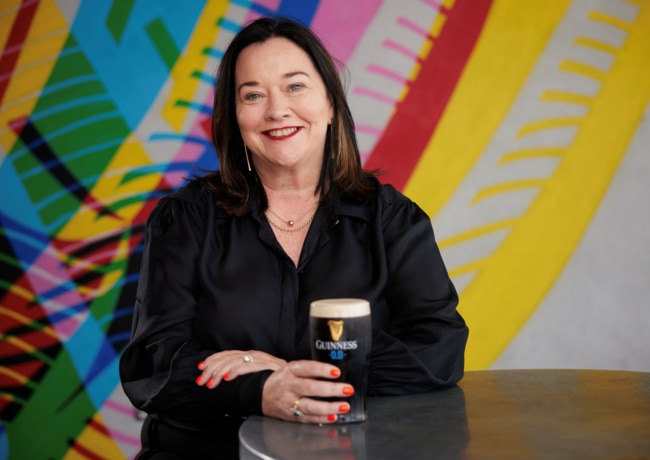More than St Patrick’s Day, Guinness chases cultural clout
Not content with sales spikes on St Patrick’s Day, Guinness has amped up its distribution and is leveraging its iconic brand status to become an every-occasion drink.

Guinness is enjoying a surge in sales and popularity as the brand pushes beyond its Irish heritage to position itself as a premium refreshing drink that can be enjoyed all year round.
The iconic drink, which traditionally experiences its top sales period during March as people celebrate St Patrick’s Day, reported a 57 per cent surge in growth in the fourth quarter last year, compared to the previous year.
In a further sign of the impact of its strategic shift, the Diageo-owned brand sold more than a million pints during the July-September quarter, with August volumes outperforming March volumes.
Diageo global category director for beer, vodka, liqueurs and convenience, Grainne Wafer, said the increases had been driven by a significant distribution drive that has seen the brand launch in 600 new locations in the last 12 months.
“St Patrick’s Day has been a natural sales spike for us, but we have been driving a very concerted effort to break beyond that footprint, both in terms of distribution and the sorts of outlets we’re in, but also the time of year,” said Ms Wafer.
In order to drive this trial, Guinness had expanded into a diverse range of new venues in the last year, “places where normally Guinness wouldn’t be, like beach bars, surf bars, cafes, restaurants and sports clubs – you know, places that people are surprised to see Guinness”
The brand has also embraced its premium quality positioning to move into more high-end premium locations.
“We’ve been on quite a journey with Guinness in terms of really leaning into the distinctiveness of the brand and the quality of the brand to make sure that everybody’s getting an absolutely beautiful pint of Guinness, whether they’re at home or in a bar.”
Ms Wafer is quick to say that even as the brand expands its presence and promotes its quality offering, it is by no means abandoning its Irish roots.
“Obviously it will always have a home in Irish bars and British bars, and on St Patrick’s Day. But the scale and opportunity for this brand is so much bigger.”
Speaking to The Growth Agenda while in Sydney last week, Ms Wafer said the local growth was in line with the brand’s performance in other key markets such as Britain, where it had overtaken dominant lager brands to become the No.1 beer.
The key driver has been a strategy to target a broader range of drinkers, including younger people and women, by becoming a more culturally relevant brand. In Britain, 25 per cent of new Guinness drinkers are women, a statistic that Ms Wafer attributes to the brand’s investment in social media and its work engaging influencers and communities.
“Guinness is a brand that has been built on years of epic TV advertising. Everybody will have their favourite Guinness ad, whether it’s surfer, swim, black or whatever, and that’s a really important part of what we’re about. But increasingly social is where we build the brand, and we build it through Guinness communities and through what we call ‘Guinfluencers’. We use social media to be close to what’s going on in consumers’ lives and, along with marketing data and precision marketing, to respond in real time to some of those social conversations that we see.”
The brand recently partnered with fashion designer JW Anderson to create a range of Guinness apparel that was showcased on the runway at Milan Fashion Week and London Fashion Week.
“In terms of really putting the brand right into the heart of culture, it’s been phenomenal. Guinness has moved from being this very singular brand drunk on a singular occasion, like St Patrick’s Day or in Europe around rugby, to being this brand that shows up in a very cool, vibrant, culturally relevant way in consumers’ lives. Guinness has been a phenomenal success story in Europe, it’s growing very quickly in the US at the moment, and in Australia and beyond that it continues to be a big success in Africa.”
The Guinness growth comes amid the well-publicised demise of beer in Australia, with beer consumption suffering consistent declines over the last decade. It also follows the craft beer trend, which was “the biggest disruption in beer in the last 60 years”.
“While beer overall might look flatter, the areas of beer that are growing are areas that are super premium and premium and that have a high degree of craft and distinctiveness. And there’s growth in what we call ‘fun and flavour’, which is RTDs or near beer. It’s the big middle area that’s under a bit of pressure, and then value is being squeezed entirely.
“With premium and distinctive beers growing that completely favours the characteristics of Guinness, which gives us a lot of confidence from a broader category perspective. There’s a lot of growth ahead, we’re a small beer here, so the headroom for growth is enormous.”
Ms Wafer said that while the zero alcohol category was undeveloped in comparison to markets in Europe where it accounted for up to 30 per cent of beer sales, it would become a significant growth area for the brand as this market matured. Guinness 0.0% outperformed company forecasts in Australia, according to Diageo.


